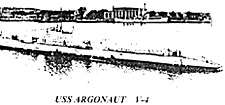The Quest for the Fleet Submarine Renewed
For several years following the war the U.S. Navy six former World War I German U-Boats to test and study these boats and their design. Plus, several submarine experts were sent to Europe to study the latest designs born from the necessities of the war. But, in general, post World War I submarine activity declined substantially because of the general demobilization and disarmament climate. This was at the time when the first of three T-Class, fleet submarines, were commissioned; but they were immediately considered obsolete by postwar standards (being designed in 1913!). They never served with the fleet because of their numerous deficiencies, and were soon taken out of service and scrapped, in 1930, in accordance with the London Naval Treaty.
However, there was considerable interest in the big, long-range submarine cruisers developed by Germany for use against Allied commerce. This and many other ideas begun during the war were taken to the extreme by several countries as they built steam driven submarines, submarines with large caliber gun turrets (12 inch British M-Class and twin 8-inchers on the French SURCOUF), and even submarines with aircraft hangars.
Meanwhile, back at home the U. S. Navy moved ahead with a follow-on design to the T-1, this was the first true Fleet Submarine. The major idea was for a 2,000 ton long range cruiser submarine armed with two large deck guns (6 inch 53 caliber) as well as torpedo tubes. During construction the design was changed several times to include some design features from the German U-Boats:
M.A.N. engines, trim pumps, air compressors and low pressure blowers for emptying the main ballast tanks.
Seakeeping ability was increased by providing a large reserve buoyancy and a flat-sided 'shark-nosed' bow from the U-Boats. The increase in reserve buoyancy was obtained through the use of a double hull (or, as mentioned above, saddle tanks) which allowed for a larger ballast tank to be installed in the space outside the pressure hull, but inside the exterior hull plating (fuel was also carried in these tanks). Surface speed was sacrificed in an unsuccessful attempt to increase engine reliability. Except for the fact that their forward engine room was in front of the conning tower, their general arrangement was approaching that of the Fleet Boats of World War II.
 Some characteristics of the first boat in this new V-1 Class were:
Some characteristics of the first boat in this new V-1 Class were:
- Length: 300 feet
Diving depth: 200 feet *
Speed: 18 knots surface; 9 knots submerged
Range: 10,000 miles surfaced @ 11 knots
Tubes (fwd): four 21: tubes
Tubes (aft): two 21" tubes (carries 6 additional reloads)
* NOTE - These submarines were longer in length than their operating depth, which made steep dives dangerous.
Due in part to their high costs only a few of the very large V-1 Class boats were built. All were awkward to maneuver, slow to dive and slow on the surface. Their heavy engines provided relatively low power and turned out to be unreliable, with severe vibration at critical engine speeds. Their torsional vibration at speeds near resonance was never solved even though vibration dampners and flexible couplers were tried. The only answer was to decouple the engine from the propeller. The riveted hulls coupled with the engine vibration meant leaky fuel tanks. All of which spelled the end for the cruiser-type super-submarine and the idea of a high-speed Fleet Submarine. This was the last attempt by the Navy to achieve a true Fleet Submarine capable of operating with the battleship squadrons.
This paper will continue in KTB #111 next month, and we will begin to read about the famous (or infamous) S-Boats which were the backbone of the Fleet prior to America's entry into WW II.
Back to KTB #110 Table of Contents
Back to KTB List of Issues
Back to MagWeb Master Magazine List
© Copyright 1995 by Harry Cooper, Sharkhunters International, Inc.
This article appears in MagWeb (Magazine Web) on the Internet World Wide Web. Other military history articles and gaming articles are available at http://www.magweb.com
Sharkhunters International, Inc., PO Box 1539, Hernando, FL 34442, ph: 352-637-2917, fax: 352-637-6289, e-m: sharkhunters@hitter.net
